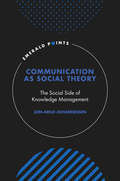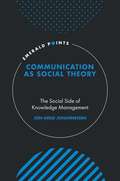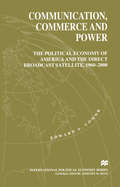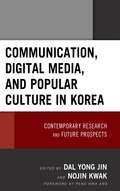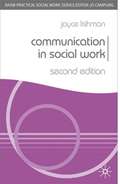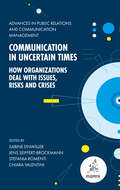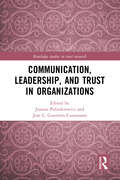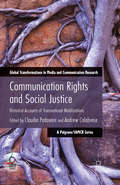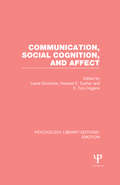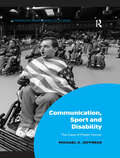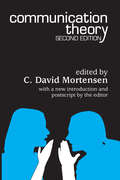- Table View
- List View
Communication as Social Theory: The Social Side of Knowledge Management (Emerald Points)
by Jon-Arild JohannessenCommunication as Social Theory: The Social Side of Knowledge Management develops a social theory at micro level, with communication as the essential social mechanism within the theory. Leadership expert Johannessen examines how we can advance communication as social theory. The communicative process has been framed as a sequence: select-create-detect. The 'select' element occurs when a positive choice to communicate something is made, thereby deselecting something else. In this book 44 case letters have been developed. These case letters are designed to deepen, underline and augment the 44 conceptual and empirical propositions that have been established. The core message is to promote change in social systems by focusing on changing micro-behaviours. In complex adaptable systems, the individual actors adapt their behaviour to each other on the basis of the local minimal rules. This means that one cannot take individual behaviour for granted, but one must instead investigate individual behaviour within specific contexts. For students of Management Studies and professionals in Leadership this work is a must for expanding their understanding.
Communication as Social Theory: The Social Side of Knowledge Management (Emerald Points)
by Jon-Arild JohannessenCommunication as Social Theory: The Social Side of Knowledge Management develops a social theory at micro level, with communication as the essential social mechanism within the theory. Leadership expert Johannessen examines how we can advance communication as social theory. The communicative process has been framed as a sequence: select-create-detect. The 'select' element occurs when a positive choice to communicate something is made, thereby deselecting something else. In this book 44 case letters have been developed. These case letters are designed to deepen, underline and augment the 44 conceptual and empirical propositions that have been established. The core message is to promote change in social systems by focusing on changing micro-behaviours. In complex adaptable systems, the individual actors adapt their behaviour to each other on the basis of the local minimal rules. This means that one cannot take individual behaviour for granted, but one must instead investigate individual behaviour within specific contexts. For students of Management Studies and professionals in Leadership this work is a must for expanding their understanding.
Communication, Commerce and Power: The Political Economy of America and the Direct Broadcast Satellite, 1960-2000 (International Political Economy Series)
by Edward A. ComorIn this history of US-based direct broadcast satellite developments, the United States and other nation-states are shown to be the ultimate arbiters of their ongoing histories. In making this now unfashionable argument, Edward A. Comor directly challenges recent academic work that tends to privilege global processes over national, and argues that the contemporary world order is being shaped primarily by transnational rather than nation-state-based forces. In testing this orientation with empirical research on US foreign communication policy since 1960, Communication, Commerce and Power compels academics and policy makers to rethink commonplace assumptions about the characteristics and potentials of the contemporary and future international political economy.
Communication, Culture and Social Change: Meaning, Co-option and Resistance (Palgrave Studies in Communication for Social Change)
by Mohan DuttaDrawing on the culture-centered approach (CCA), this book re-imagines culture as a site for resisting the neocolonial framework of neoliberal governmentality. Culture emerged in the 20th Century as a conceptual tool for resisting the hegemony of West-centric interventions in development, disrupting the assumptions that form the basis of development. This turn to culture offered radical possibilities for decolonizing social change but in response, necolonial development institutions incorporated culture into their strategic framework while simultaneously deploying political and economic power to silence transformative threads. This rise of “culture as development” corresponded with the global rise of neo-liberal governmentality, incorporating culture as a tool for globally reproducing the logic of capital. Using examples of transformative social change interventions, this book emphasizes the role of culture as a site for resisting capitalism and imagining rights-based, sustainable and socialist futures. In particular, it attends to culture as the basis for socialist organizing in activist and party politics. In doing so, Culture, Participation and Social Change offers a framework of inter-linkage between Marxist analyses of capital and cultural analyses of colonialism. It concludes with an anti-colonial framework that re-imagines the academe as a site of activist interventions.
Communication, Digital Media, And Popular Culture In Korea: Contemporary Research And Future Prospects (PDF)
by Kim Jin Youm PaeIn recent decades, Korean communication and media have substantially grown to become some of the most significant segments of Korean society. Since the early 1990s, Korea has experienced several distinctive changes in its politics, economy, and technology, which are directly related to the development of local media and culture. Korea has greatly developed several cutting-edge technologies, such as smartphones, video games, and mobile instant messengers to become the most networked society throughout the world. As the Korean Wave exemplifies, the once small and peripheral Korea has also created several unique local popular cultures, including television programs, movies, and popular music, known as K-pop, and these products have penetrated many parts of the world. As Korean media and popular culture have rapidly grown, the number of media scholars and topics covering these areas in academic discourses has increased. These scholars' interests have expanded from traditional media, such as Korean journalism and cinema, to several new cutting-edge areas, like digital technologies, health communication, and LGBT-related issues. In celebrating the Korean American Communication Association's fortieth anniversary in 2018, this book documents and historicizes the growth of growing scholarship in the realm of Korean media and communication.
Communication in Social Work: The Commonwealth and International Library: Social Work Division
by Peter R. DayCommunication in Social Work focuses on the role of communication in social work. This book discusses aspects of communication in the helping process and illustrates where information and advice on their own would not have been helpful to the client. Comprised of seven chapters, this book begins with an overview of the nature of communication and explains why a study of the communication process may help in dealing with serious problems of the environment and human relations. Attention then turns to communication processes in social work, with emphasis on the role of non-verbal behavior in the interaction between social worker and client, along with the factors that influence communication between them. The chapters that follow focus on social factors in communication, considering the sociological view of social work as a mechanism of social control, as well as the importance of communication in the helping process. This book concludes by explaining how social agency contributes to the nature of the social worker's activities, touching on topics such as problems of cooperation and coordination in social welfare. This text will be of interest to professionals and policymakers involved in social work.
Communication In Social Work (PDF)
by Joyce Lishman Jo CamplingThis timely new edition identifies the important skills integral to effective communication in social work. Based on the premise that good communication skills are essential to good social work, the second edition offers an extended account of its subject that pays more attention to the diverse contexts of social work and the range of clients and users with whom practitioners come in contact.
Communication in Uncertain Times: How Organizations Deal with Issues, Risks and Crises (Advances in Public Relations and Communication Management #7)
by SABINE EINWILLER, JENS SEIFFERT-BROCKMANN, STEFANIA ROMENTI AND CHIARA VALENTINITechnological developments and globalization have not only propelled societal progress, but they have also ushered in significant challenges and risks that continually demand responses and adaptability from today’s dynamic and complex societies. In this context, organizations find themselves grappling with the need to navigate and manage these challenges effectively. For public relations scholars and practitioners, this reality poses crucial questions concerning communication strategies and their impact in today’s risk societies. Communication in Uncertain Times explores how different organizations, from private to governmental and non-profit, deal with issues, risks, and crisis situations through communication. Questions include how to address risks and issues to decrease uncertainty, how to negotiate conflicts, and what types of roles professionals and non-professional communicators assume in times of risk, uncertainty, and crises. The chapters comprise selected contributions to the 2022 Annual Congress of the European Public Relations Education and Research Association (EUPRERA) hosted in Vienna, Austria, by the University of Vienna and the Vienna University of Economics and Business. Advances in Public Relations and Communication Management (APCRM) is a publication of the European Public Relations Education and Research Association (EUPRERA). Each volume includes contributions from EUPRERA’s annual congress and follow the theme of each event.
Communication in Uncertain Times: How Organizations Deal with Issues, Risks and Crises (Advances in Public Relations and Communication Management #7)
by Chiara Valentini Stefania Romenti Jens Seiffert-Brockmann Sabine EinwillerTechnological developments and globalization have not only propelled societal progress, but they have also ushered in significant challenges and risks that continually demand responses and adaptability from today’s dynamic and complex societies. In this context, organizations find themselves grappling with the need to navigate and manage these challenges effectively. For public relations scholars and practitioners, this reality poses crucial questions concerning communication strategies and their impact in today’s risk societies. Communication in Uncertain Times explores how different organizations, from private to governmental and non-profit, deal with issues, risks, and crisis situations through communication. Questions include how to address risks and issues to decrease uncertainty, how to negotiate conflicts, and what types of roles professionals and non-professional communicators assume in times of risk, uncertainty, and crises. The chapters comprise selected contributions to the 2022 Annual Congress of the European Public Relations Education and Research Association (EUPRERA) hosted in Vienna, Austria, by the University of Vienna and the Vienna University of Economics and Business. Advances in Public Relations and Communication Management (APCRM) is a publication of the European Public Relations Education and Research Association (EUPRERA). Each volume includes contributions from EUPRERA’s annual congress and follow the theme of each event.
Communication, Leadership and Trust in Organizations (Routledge Studies in Trust Research)
by Joanna Paliszkiewicz Cusumano, Jose L. GuerreroTrust in communication and leadership is the key to success in business. This book presents and discusses the main issues and challenges posed by communication, leadership, and trust. The first part of the book describes the communication and trust issues, the second part presents the role of trust in leadership, and the third part describes different examples of implementing trust to organizations. Readers will gain from this book theoretical and practical knowledge of communication, leadership, and trust; empirically validated practice regarding trust and its related concepts; and a novel approach for addressing this topic. This book can be used as a toolbox to improve understanding and opportunities related to building trust in organizations and will be especially valuable for students and researchers in the fields of leadership, organizational communication, business ethics, and trust research.
Communication, Leadership and Trust in Organizations (Routledge Studies in Trust Research)
by Joanna Paliszkiewicz José L. Guerrero CusumanoTrust in communication and leadership is the key to success in business. This book presents and discusses the main issues and challenges posed by communication, leadership, and trust. The first part of the book describes the communication and trust issues, the second part presents the role of trust in leadership, and the third part describes different examples of implementing trust to organizations. Readers will gain from this book theoretical and practical knowledge of communication, leadership, and trust; empirically validated practice regarding trust and its related concepts; and a novel approach for addressing this topic. This book can be used as a toolbox to improve understanding and opportunities related to building trust in organizations and will be especially valuable for students and researchers in the fields of leadership, organizational communication, business ethics, and trust research.
Communication of Smart Media
by Peng Duan Lei Zhang Kai Song Xiao HanThis book provides the readers with an interdisciplinary perspective on communication in the diffuse boundaries that also demonstrates the diversity and inclusion for presenting wide range and rapid changes in contents, and the authors use “smart” as the guiding principle while indicate “communication” has been defined as a core feature. Appropriately, the book is divided into eight major sections. As always, the inevitable result of upgrading and constant iterations of developing new communication technology, the media communication has turned out to be one of the most important means in the smart era. The book sheds new light on virtual reality (VR), a pioneering technology in smart media communication, as an entry point to explore why the core social networks of smart news and smart media communication could occupy the central position in smart media communication while to discuss issues such as platform society built using smart media communication, and further elaborate on the integration of 5G technology, media and social transformation. This book not merely covers disciplines such as journalism and communication, but also on the universal application of smart media communication, and furthermore, it provides practical guidance and reviews cutting-edge ideas. It serves as a good future reference to help scholars, graduate students as well as relevant professionals for thinking outside the box that in order to continually expand reader’s knowledge and professional capabilities, especially aware of the impact of observation and judgment, value analysis and lifelong learning.
Communication, Public Discourse, and Road Safety Campaigns: Persuading People to Be Safer (Routledge Studies in Rhetoric and Communication)
by Nurit GuttmanThis book discusses the use of communication campaigns to promote road safety, arguing that they need to elicit public discourse on issues pertaining to culture, equity, gender, workplace norms, environmental issues, and social solidarity. Increasingly, new media channels and formats are employed in the dissemination process, making road safety-related messages ubiquitous, and often controversial. Policy makers, educators, researchers, and the public continue to debate the utility and morality of some of the influence tactics employed in these messages, such as the use of graphic images of injury or death, stigmatization (or "blame and shame"), and the use of "black humor." Guttman argues that influencing road safety requires making changes in normative and cultural conceptions of broader issues in society, yet the typical discourse on road safety tends to focus on individual attitudes and practices. The book highlights the importance of social and behavioral theory in communication campaigns on road safety, and critiques the tendency to focus on individual cognition, affect, and risk conceptions rather than on normative, structural, and cultural factors. The volume positions the discourse on road safety as a social issue, and treats road safety behavior as a social activity that directly relates to other public issues, social values, and social policy, while discussing potential uses of social media and participatory approaches. The discussion turns to the role of road safety communication campaigns as part of a democratic process of eliciting public discourse, including how contemporary society could address broader issues of risk and safety.
Communication, Public Discourse, and Road Safety Campaigns: Persuading People to Be Safer (Routledge Studies in Rhetoric and Communication)
by Nurit GuttmanThis book discusses the use of communication campaigns to promote road safety, arguing that they need to elicit public discourse on issues pertaining to culture, equity, gender, workplace norms, environmental issues, and social solidarity. Increasingly, new media channels and formats are employed in the dissemination process, making road safety-related messages ubiquitous, and often controversial. Policy makers, educators, researchers, and the public continue to debate the utility and morality of some of the influence tactics employed in these messages, such as the use of graphic images of injury or death, stigmatization (or "blame and shame"), and the use of "black humor." Guttman argues that influencing road safety requires making changes in normative and cultural conceptions of broader issues in society, yet the typical discourse on road safety tends to focus on individual attitudes and practices. The book highlights the importance of social and behavioral theory in communication campaigns on road safety, and critiques the tendency to focus on individual cognition, affect, and risk conceptions rather than on normative, structural, and cultural factors. The volume positions the discourse on road safety as a social issue, and treats road safety behavior as a social activity that directly relates to other public issues, social values, and social policy, while discussing potential uses of social media and participatory approaches. The discussion turns to the role of road safety communication campaigns as part of a democratic process of eliciting public discourse, including how contemporary society could address broader issues of risk and safety.
Communication Rights and Social Justice: Historical Accounts of Transnational Mobilizations (Global Transformations in Media and Communication Research - A Palgrave and IAMCR Series)
by Claudia Padovani Andrew CalabresePlacing struggles for communication rights within the broader context of human rights struggles in the twentieth and twenty-first centuries, this broad-based collection offers a rich range of illustrations of national, regional and global struggles to define communication rights as essential to human needs and happiness.
Communication, Social Cognition, and Affect (Psychology Library Editions: Emotion)
by E. Tory Higgins Lewis Donohew Howard E. SypherOriginally published in 1988, the purpose of this book was to explore the interrelations among communication, social cognition and affect. The contributors, selected by the editors, were some of the best known in their fields and they significantly added to the knowledge of this interdisciplinary domain at the time. In late April 1986 the authors met at a conference centre at the University of Kentucky. They presented first drafts of their chapters and exchanged ideas. Out of these interactions came this book, which has a broad interest across several areas of psychology and communication. While answering a number of questions, the authors also posed others for future examination.
Communication, Social Cognition, and Affect (Psychology Library Editions: Emotion)
by E. Tory Higgins Lewis Donohew Howard E. SypherOriginally published in 1988, the purpose of this book was to explore the interrelations among communication, social cognition and affect. The contributors, selected by the editors, were some of the best known in their fields and they significantly added to the knowledge of this interdisciplinary domain at the time. In late April 1986 the authors met at a conference centre at the University of Kentucky. They presented first drafts of their chapters and exchanged ideas. Out of these interactions came this book, which has a broad interest across several areas of psychology and communication. While answering a number of questions, the authors also posed others for future examination.
Communication, Social Structure and Development in Rural Malaysia: A Study of Kampung Kuala Bera
by William WilderThis is an important innovative analysis of communication and society in Pahang, West Malaysia, based on fieldwork carried out in Kampung Kuala Bera. Dr Wilder is concerned with communication networks of all kinds as found in a long-established Malay village, including the uses of language, small-scale (kinship and village-based) networks, and higher-level systems (the district and the nation as a whole). Dr Wilder lays particular emphasis on the role of communication in the process of economic development and on administration during a period of rapid and induced social change. His study is prefaced by a detailed historical account of Pahang and a thorough sociological analysis of Kampung Kuala Bera. The ethnography is meticulously detailed; its special contribution includes the first-ever publication of a Malay village genealogy, a systematic account of birth-order names (a major feature of the kinship system), complete figures on marital breakdowns for the whole village population, and an intensive analysis of leadership in its local context. This work will be of value to students of Southeast Asian societies, rural sociology, network studies, economic development, political education and the mass media in third world countries.
Communication, Social Structure and Development in Rural Malaysia: A Study of Kampung Kuala Bera
by William WilderThis is an important innovative analysis of communication and society in Pahang, West Malaysia, based on fieldwork carried out in Kampung Kuala Bera. Dr Wilder is concerned with communication networks of all kinds as found in a long-established Malay village, including the uses of language, small-scale (kinship and village-based) networks, and higher-level systems (the district and the nation as a whole). Dr Wilder lays particular emphasis on the role of communication in the process of economic development and on administration during a period of rapid and induced social change. His study is prefaced by a detailed historical account of Pahang and a thorough sociological analysis of Kampung Kuala Bera. The ethnography is meticulously detailed; its special contribution includes the first-ever publication of a Malay village genealogy, a systematic account of birth-order names (a major feature of the kinship system), complete figures on marital breakdowns for the whole village population, and an intensive analysis of leadership in its local context. This work will be of value to students of Southeast Asian societies, rural sociology, network studies, economic development, political education and the mass media in third world countries.
Communication, Sport and Disability: The Case of Power Soccer (Interdisciplinary Disability Studies)
by Michael S. JeffressSports are ubiquitous in American society, and given their prominence in the culture, it is easy to understand how most youth in the United States face pressure to participate in organized sports. But what does this mean for the hundreds of thousands of Americans who live with one or more physical disabilities and, in particular, those in powered wheelchairs? Located at the intersection of sports and disability, this book tells the story of power soccer - the first competitive team sport specifically designed for electric wheelchair users. Beginning in France in the 1970s, today, over sixty teams compete within the United States Power Soccer Association (USPSA) and the sport is actively played in over thirty countries. Using ethnographic research conducted while attending practices, games, and social functions of teams from across the nation, Jeffress builds a strong case that electric wheelchair users deserve more opportunity to play sports. They deserve it because they need the same physical and psychosocial benefits from participation as their peers, who have full use of their arms and legs. It challenges the social constructions and barriers that currently stand in the way. Most importantly, this book tells the story of some amazing power soccer athletes. It is a moving, first-hand account of what power soccer means to them and the implications this has for society.
Communication, Sport and Disability: The Case of Power Soccer (Interdisciplinary Disability Studies)
by Michael S. JeffressSports are ubiquitous in American society, and given their prominence in the culture, it is easy to understand how most youth in the United States face pressure to participate in organized sports. But what does this mean for the hundreds of thousands of Americans who live with one or more physical disabilities and, in particular, those in powered wheelchairs? Located at the intersection of sports and disability, this book tells the story of power soccer - the first competitive team sport specifically designed for electric wheelchair users. Beginning in France in the 1970s, today, over sixty teams compete within the United States Power Soccer Association (USPSA) and the sport is actively played in over thirty countries. Using ethnographic research conducted while attending practices, games, and social functions of teams from across the nation, Jeffress builds a strong case that electric wheelchair users deserve more opportunity to play sports. They deserve it because they need the same physical and psychosocial benefits from participation as their peers, who have full use of their arms and legs. It challenges the social constructions and barriers that currently stand in the way. Most importantly, this book tells the story of some amazing power soccer athletes. It is a moving, first-hand account of what power soccer means to them and the implications this has for society.
Communication Theory
by C. David MortensenCommunication is the most complex and elevating achievement of human beings. Most people spend up to 70 percent of our waking hours engaged in some form of communication. Listening and responding to the messages of others occupies much of this time; the rest is taken up by talking, reading, and writing. An additional consideration is the rich assortment of nonverbal cues humans share, which also constitute a form of communication. All together, the stream of verbal and nonverbal information that bombards our senses is composed of as many as 2,000 distinguishable units of interaction in a single day. The kinds of interaction change constantly: morning greetings, cereal labels, bus signs, charts, traffic lights, hate stares, graffiti, coffee shop chat, gestures, laughter, and head nods: The themes are endless. All of this constitutes subject matter for the study of communication.The book seeks to acquaint students with a basic understanding of the process of human communication. The breadth and scope of subject matter is adaptable to a number of approaches to the first course in communication, whether theoretical, practical, contemporary, or traditional in orientation.The framework of this book introduces five topics of central interest to the field of communication theory. Part I describes the process of communication as it unfolds in face-to-face environments. Part II considers the symbolic significance of interpersonal behavior. Part III examines the organization of communicative acts and shows why human interactions tend to become more synchronous over time. Part IV explores the complex problem of understanding other people, demonstrating the tendency of understanding to become intersubjective. Part V accounts for the communicative significance of several basic human environments--communities, organizations, media, institutions, and culture.
Communication Theory
by C. David MortensenCommunication is the most complex and elevating achievement of human beings. Most people spend up to 70 percent of our waking hours engaged in some form of communication. Listening and responding to the messages of others occupies much of this time; the rest is taken up by talking, reading, and writing. An additional consideration is the rich assortment of nonverbal cues humans share, which also constitute a form of communication. All together, the stream of verbal and nonverbal information that bombards our senses is composed of as many as 2,000 distinguishable units of interaction in a single day. The kinds of interaction change constantly: morning greetings, cereal labels, bus signs, charts, traffic lights, hate stares, graffiti, coffee shop chat, gestures, laughter, and head nods: The themes are endless. All of this constitutes subject matter for the study of communication.The book seeks to acquaint students with a basic understanding of the process of human communication. The breadth and scope of subject matter is adaptable to a number of approaches to the first course in communication, whether theoretical, practical, contemporary, or traditional in orientation.The framework of this book introduces five topics of central interest to the field of communication theory. Part I describes the process of communication as it unfolds in face-to-face environments. Part II considers the symbolic significance of interpersonal behavior. Part III examines the organization of communicative acts and shows why human interactions tend to become more synchronous over time. Part IV explores the complex problem of understanding other people, demonstrating the tendency of understanding to become intersubjective. Part V accounts for the communicative significance of several basic human environments--communities, organizations, media, institutions, and culture.
Communication Under the Microscope: The Theory and Practice of Microanalysis
by Peter BullSocial interaction in recent years has become the focus of systematic scientific research in a wide variety of academic disciplines. In Communication under the Microscope, Peter Bull shows how communication has become an object of study in its own right, which can be dissected in the finest detail through the use of film and recording technology. In so doing he provides a clear and valuable introduction into the theory and practice of microanalysis.Bull argues that microanalysis is both a distinctive methodology and a distinctive way of thinking about communication. He then focuses on the two principal elements of face-to-face communication: speech and non-verbal behaviour. Communication in particular social contexts is also addressed with related chapters on gender and politics. Finally, the practical aspects of microanalysis are discussed.This unique and thorough review of microanalysis integrates different approaches and draws together research literature which is often diverse and disparate. Presented in a clear and focused style, this book will be of interest to psychologists, social scientists and all students and researchers in the field of communication.Communication is central to many aspects of human life, yet it has only recently become the focus of systematic scientific investigation within a wide variety of academic disciplines. Communication has now become an object of study in its own right, and can be dissected in the finest detail with the use of recording technology (film, audiotape and videotape). This approach has become known as 'microanalysis', and forms the principal theme of Communication under the Microscope.
Communication Under the Microscope: The Theory and Practice of Microanalysis
by Peter BullSocial interaction in recent years has become the focus of systematic scientific research in a wide variety of academic disciplines. In Communication under the Microscope, Peter Bull shows how communication has become an object of study in its own right, which can be dissected in the finest detail through the use of film and recording technology. In so doing he provides a clear and valuable introduction into the theory and practice of microanalysis.Bull argues that microanalysis is both a distinctive methodology and a distinctive way of thinking about communication. He then focuses on the two principal elements of face-to-face communication: speech and non-verbal behaviour. Communication in particular social contexts is also addressed with related chapters on gender and politics. Finally, the practical aspects of microanalysis are discussed.This unique and thorough review of microanalysis integrates different approaches and draws together research literature which is often diverse and disparate. Presented in a clear and focused style, this book will be of interest to psychologists, social scientists and all students and researchers in the field of communication.Communication is central to many aspects of human life, yet it has only recently become the focus of systematic scientific investigation within a wide variety of academic disciplines. Communication has now become an object of study in its own right, and can be dissected in the finest detail with the use of recording technology (film, audiotape and videotape). This approach has become known as 'microanalysis', and forms the principal theme of Communication under the Microscope.
